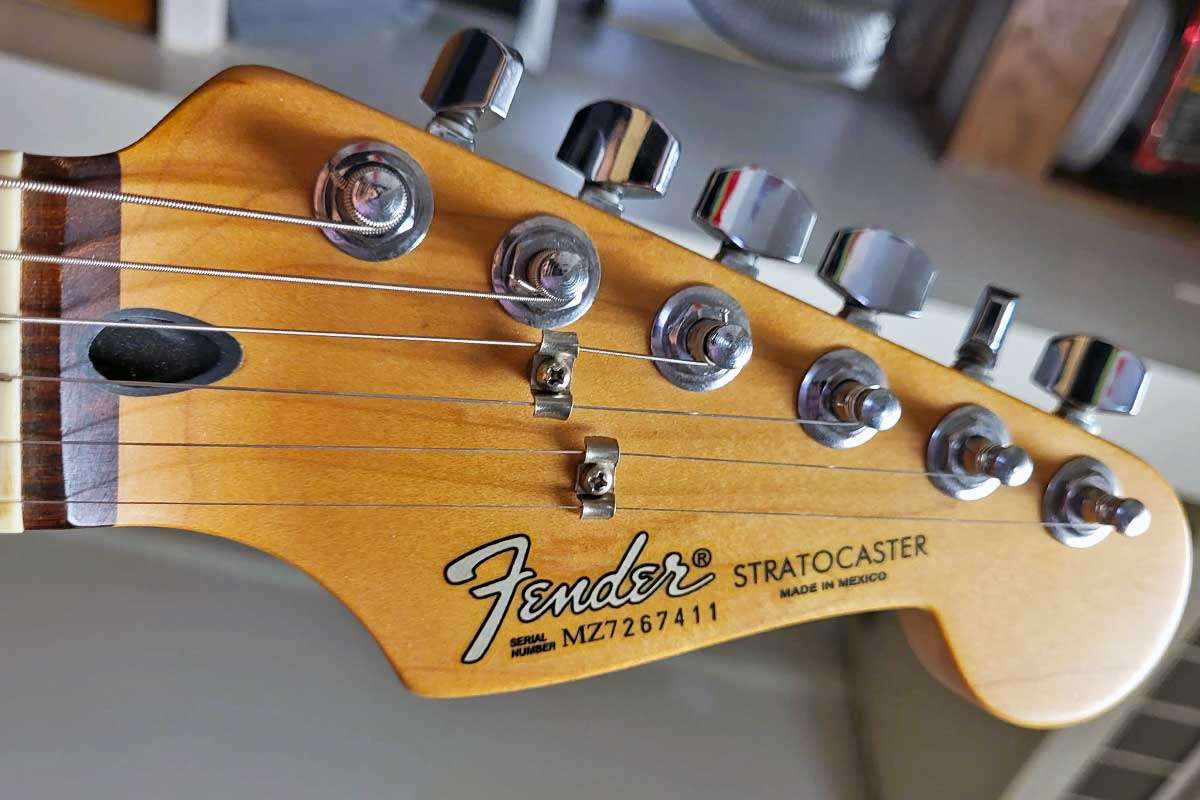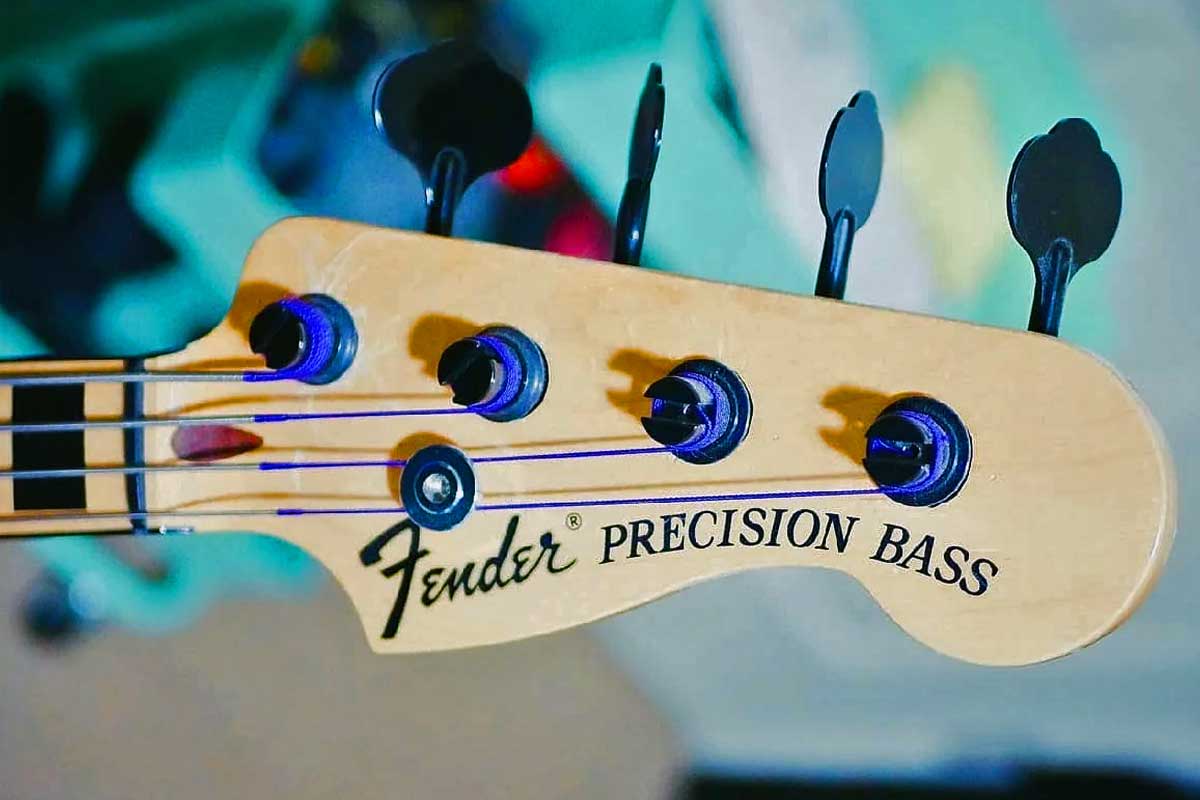The guitar string tree, a small but crucial component found on many electric guitar headstocks, plays a vital role in maintaining proper string tension and angle. This simple device ensures that strings, particularly the thinner ones, maintain adequate downward pressure as they pass over the nut.
By creating a steeper break angle, the string tree helps prevent buzzing and tuning instability, especially on guitars with flat headstocks. Its presence contributes to consistent tonality and sustain across all strings, enhancing the instrument’s overall playability and sound quality.
Understanding the function of a string tree is essential for both guitar setup and maintenance, as it directly impacts the instrument’s performance.
Key Takeaways:
- String trees are small but crucial components that maintain proper string tension and angle on guitar headstocks, especially for thinner strings.
- They help prevent buzzing and tuning instability by creating a steeper break angle for strings, particularly on guitars with flat headstocks.
- Various types of string trees exist, including butterfly, barrel, and roller styles, made from materials like metal, plastic, and synthetic composites.
- Proper installation and maintenance of string trees are essential for optimal guitar performance and to avoid issues like buzzing or rattling.
- String trees impact tuning stability, sound quality, and interact with other guitar components, but their necessity can vary depending on headstock design and guitar type.
Related: The Anatomy of An Electric Guitar

Guitar String Trees Explained
In the construction of electric guitars, string trees are small but vital components that ensure proper string tension and stability across the fretboard.
Purpose & Function
String trees, also known as string retainers or guides, are small fittings attached to the headstock of a guitar. Their main purpose is to maintain downward pressure on the strings as they pass from the nut to the tuning pegs, particularly for the thinner strings that can sit at a shallower angle. This pressure helps to prevent string buzz and maintain tuning stability by reducing friction at the nut, which ensures a clearer tone.
Varieties and Materials
There are several varieties of string trees available. The butterfly style is a common design that exerts pressure on the strings with its wings, while the barrel style and disc string tree varieties offer a different aesthetic and functional approach. Roller string trees have small rolling barrels that reduce friction when the strings move, which is especially beneficial during tremolo use.
Material-wise, string trees are made from various substances. Graphite string trees minimize friction due to the self-lubricating properties of graphite, which is ideal for maintaining tuning stability. On the other hand, Graph Tech string trees are renowned for their quality and durability, which can enhance the overall performance of the guitar. Materials can range from plastic and metal to synthetic composites, each affecting the string’s angle and pressure differently.
Guitar String Retainer Installation & Maintenance
When installing a guitar string tree, your goal is to ensure proper tension across the nut and to maintain tuning stability. Proper installation is crucial to avoid common issues such as string buzz or rattle.
Installation Process
To install a string tree, you’ll need to align it correctly with the tuners on the headstock. First, identify where the string tree should be placed – it’s typically located above the G and B tuners on a standard six-string guitar.
- Measure the distance: Place the string tree between the nut and the tuning posts. It should be in line with the string slots of the nut and the tuning post holes.
- Mark the spot: Once you find the right position, use a pencil to mark where you’ll drill the pilot hole for the string tree.
- Drill the pilot hole: Use a drill bit that’s slightly smaller than the screw you’ll be using for the string tree to drill a pilot hole.
- Fasten the tree: Align the string tree with the pilot hole and use a screwdriver to fasten the metal widget securely. Be cautious not to overtighten and strip the screw.
Common Issues & Solutions
- Buzzing: If you experience buzzing after installation, check if the tree’s too tight – a slight loosening may be required.
- Rattle: A rattle indicates that the tree isn’t properly secured. Tighten the screw slightly but avoid over-tightening, which can strip the screw.
| Issue | Potential Cause | Solution |
|---|---|---|
| Buzzing | Over-tightening | Loosen string tree |
| Rattle | Loose screw | Tighten screw, ensure proper fit |
| Tuning Problems | Improper spacing | Recheck positioning relative to post |
- Wear: Metallic wear can occur over time, affecting sustain. Replace the string tree if visible wear is evident.
- Tuning Problems: If tuning problems persist, consider the spacer’s height; an incorrect spacer may cause strings to sit too high or too low.
Impact on Guitar Performance
The performance of your guitar is significantly influenced by the use of a string tree, which affects tuning stability, sound quality, and how the instrument interacts with its components.
Tuning Stability and Intonation
String trees are pivotal in maintaining tuning stability on your guitar, especially for the B and high E strings, which often pass through a longer distance from the nut to the tuning pegs on many headstocks. The added tension helps prevent these strings from slipping out of tune, which can be crucial during bending or using a tremolo arm. For Fender-style guitars, which typically feature a longer headstock, a correctly installed string retainer can reduce erratic string behavior and increase intonation accuracy by ensuring the nut slot is firmly seated under tension.
Impact on Sound Quality
The sound quality of your guitar can be subtly altered by the presence of string trees. They guide the D string and G string to create the correct break angle at the nut, which can affect tonal consistency. However, if the tension is too high or the tree is improperly positioned, it can introduce unwanted stress and potentially dampen the string’s tone and resonance. For optimal effect, some guitarists prefer using a roller string tree, which reduces friction, or locking tuners, which may eliminate the need for string trees altogether.
Interaction with Other Components
A guitar’s playability is a complex interaction between various components. The string tree is no exception, with its performance closely linked with the bridge, whammy bar, and locking tuners. On a Strat or other Fender-style guitar, where a tremolo system is often used, the consistent tuning stability provided by a string tree can be even more critical. String trees work in conjunction with these elements to ensure your playing experience remains uninterrupted by tuning concerns, allowing you to focus on the expressive possibilities of your instrument.
Design Considerations for Different Guitar Types
When designing guitars, whether they’re electric or bass, several considerations impact both functionality and aesthetics. Your choice of components and construction affects string tension, access to tuners, and the instrument’s overall balance.

Electric Guitars
Electric guitars often feature flat headstocks with inline tuners. On Fender-style headstocks like those on Stratocasters and Telecasters, you’ll find string trees that guide high strings (like the E and B strings) to create appropriate tension across the nut. Without string trees, the break angle of the strings may be insufficient, potentially leading to tuning instability or buzz. However, string trees can create friction, so rollers are sometimes used to facilitate smoother tuning and reduce wear.
Design nuances for headstocks are significant. For instance, angled headstocks found on guitars like Gibson models remove the need for string trees by providing a steeper angle for the strings. When creating your guitar, decide if an angled headstock fits your style or if the classic design with string trees will meet your needs.

Bass Guitars
On bass guitars, the greater string diameters and longer scale length introduce additional design complexities. Bass headstocks can be both angled or flat, but due to the increased tension of bass strings, the distance from the nut to the machine head becomes more critical for maintaining intonation and preventing string slippage.
Most bass guitars don’t require string trees. However, if you’re dealing with a flat headstock and find that the break angle of the strings is not steep enough to provide a firm seat in the nut—especially for the lower-pitched strings—a string retainer bar can be installed to increase the downward force exerting on the strings without the sharp angles that could lead to string breakage.
Keep in mind that the placement and quality of tuners, whether on a Fender-style or more modern bass headstock, can significantly influence tuning stability and, in turn, affect your performance.
